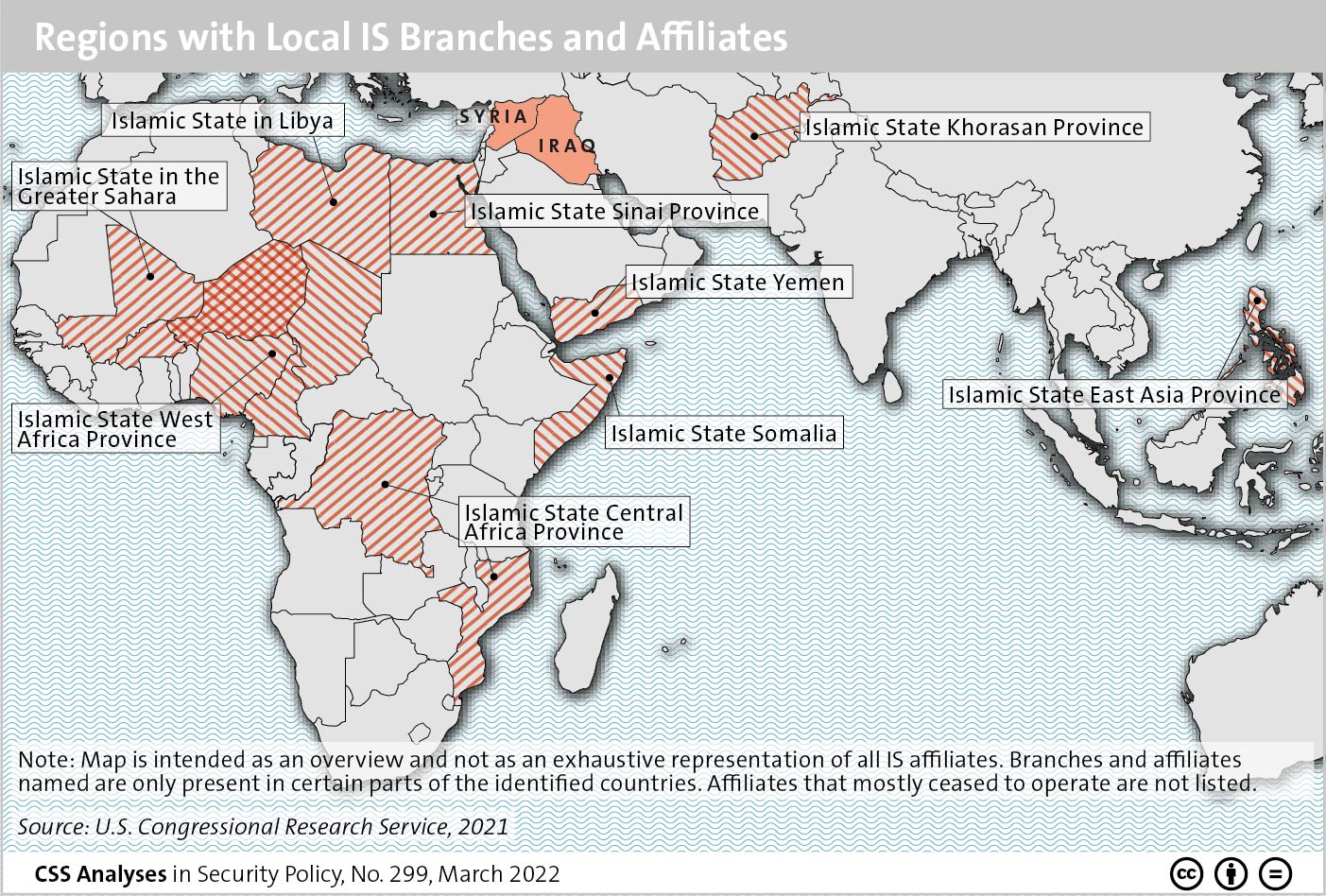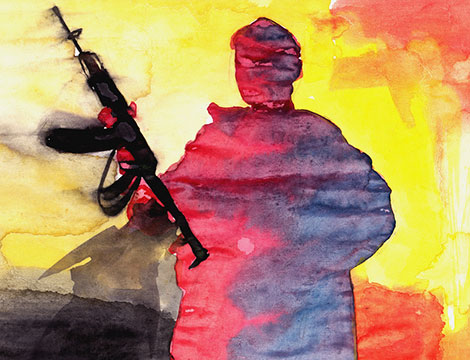
This week’s featured graphic shows the core IS’ state as of March 2022 as well as its affiliates in Africa, the Middle East and Asia. For a deeper assessment of the danger the IS still poses, read Fabien Merz’ CSS Analysis in Security Policy here.

This week’s featured graphic shows the core IS’ state as of March 2022 as well as its affiliates in Africa, the Middle East and Asia. For a deeper assessment of the danger the IS still poses, read Fabien Merz’ CSS Analysis in Security Policy here.

This article was originally published by War on the Rocks on 12 March 2018.
Nearly three years on from the Islamic State’s high water mark in the summer of 2015, there are several lessons that the United States and its allies can discern from the terrorist group’s meteoric rise to control large parts of Iraq and Syria to the loss of its physical caliphate late last year. The steady decline in ISIL’s fortunes is striking given the palpable fear its rise in the summer of 2014 sparked across Washington, when a common question circulating within the policy community was whether Baghdad itself might fall. Many of these takeaways will be relevant to U.S. policymakers as they attempt to prevent the group from reconstituting itself in the coming months.

This article was originally published by the Foreign Policy Research Institute (FPRI) on 1 September 2017.
Though seldom mentioned in the same breath as prolific Western jihadi producers such as France, Germany, and Belgium, Canada has a long and often overlooked history of producing jihadists. From the “Millennium Bomber” and the “Toronto 18” to the “Ottawa 3” and the “Calgary cluster,” jihadis have organized on Canadian soil to carry out attacks, both in-country and around the world. While Canadians have fought on jihadi battlefields as far flung as Afghanistan and Syria, their government has failed to implement comprehensive counterterrorism and deradicalization measures. Lagging far behind its Western allies, Canada implemented its first counterterrorism strategy in 2012 and has yet to create a desperately needed nationwide deradicalization program. The rise of ISIS and lone wolf attacks has increased the need for these reforms.
Though the United States has a Muslim population over triple the size of that of its northern neighbor, the two countries have seen an approximately equal number of their citizens join the Islamic State (see Graph 1 below). Canada is more similar to Italy and Switzerland—European countries far closer to the Islamic State—in terms of fighters sent in relation to its Muslim/overall population than to the equidistant United States (see Graphs 2 and 3 below). The defeat of the territorially based Islamic State will surely herald an influx of Canadian jihadists to their home country. However, the provisions introduced in the Combating Terrorism Act of 2012 and strengthened in the Anti-Terrorism Act of 2015, which prescribe lengthy prison sentences for any citizen “knowingly participating in or contributing to any activity of a terrorist group for the purpose of enhancing the ability of any terrorist group to commit a terrorist activity,” will do a great deal to mitigate the risks from this group. The greater threat to Canada lies in the radicals who never travelled to the Islamic State, thereby making themselves known to Canadian intelligence services, but instead remain embedded amongst the Canadian population. While there are a number of potential policies that Canada could implement to help combat homegrown jihadism, this analysis posits that a more comprehensive and reformed implementation of the Canadian Multiculturalism Act (CMA) and the creation of a national deradicalization program offer the two most pragmatic solutions to mitigate the threat posed by Canadian jihadis to Canada.

This article was originally published by the S. Rajaratnam School of International Studies (RSIS) on 22 August 2017.
Synopsis
As the Western Mindanao Command (Westmincom) closes in on the dwindling number of IS militants in Marawi, various terrorist tactics learned from the wars in Iraq and Syria are being replicated to worsen the conflict in southern Philippines and spread IS influence in the region.
Commentary
The Armed Forces of the Philippines (AFP) has managed to recapture most of Marawi back from the Maute Group and its acolytes despite the military’s lack of familiarity with urban warfare and the terrain. Westmincom has made “great advances” addressing the “complicated” issues on the ground even though it missed the deadline for retaking Marawi fully or wiping out terrorism from Mindanao by June 2017.
However, for the Maute Group and other terrorist groups in Mindanao, the eventual loss of Marawi will not be so much of a setback as the beginning of bolder military moves to capture territory, even if briefly, to demonstrate their fighting capability and rally support for the so-called Islamic State (IS) in the region, especially in the wake of IS military defeats in Iraq and Syria.

This article was originally published by the Institute for Security Studies (ISS) on 4 August 2017.
Most al-Shabaab members refused Farmajo’s offer – he must now defeat the group within two years as promised.
Somali President Mohamed Abdullahi Mohamed (Farmajo) has employed a classic carrot-and-stick approach to al-Shabaab since taking office in February. In early April, Farmajo announced a 60-day amnesty for al-Shabaab militants, while also offering to open discussions with the movement’s leadership.
At the same time, he noted that Somalia was in a state of war, and promised to eradicate within two years those who didn’t take advantage of his offer to surrender. With the presumed expiration of that amnesty, it is clear which path most of al-Shabaab has chosen, but what is less clear is the Somali government’s ability to respond.
The provision of an amnesty was not a novel concept, as it followed on similar offers by previous Somali governments. With the election of the popular, less clan-inclined, and seemingly incorruptible Farmajo, however, there was some speculation that there may be a genuine opportunity for engagement with al-Shabaab. At an official level this was quickly squashed by top al-Shabaab leaders.